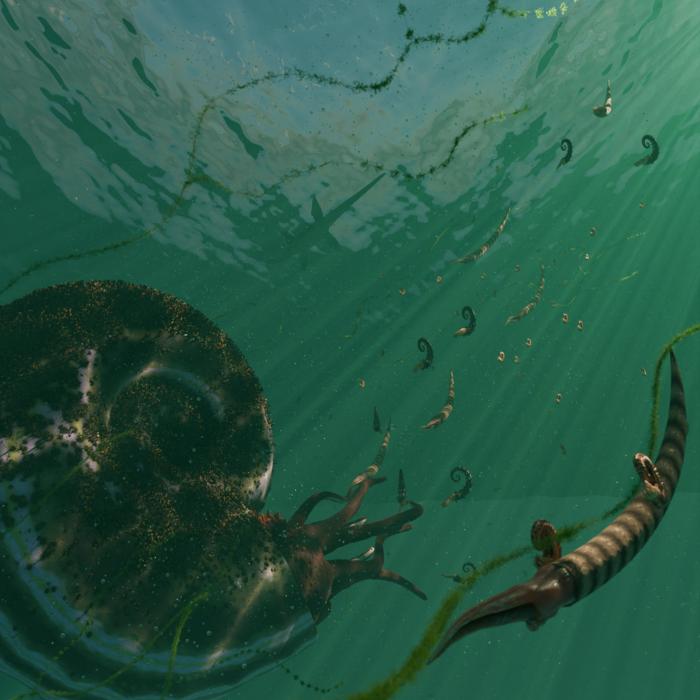Los Angeles, CA (June 27, 2024) —A new study published in the journal Nature Communications led by paleontologists at the University of Bristol along with a team of international researchers, including Dr. Austin Hendy, Curator of Invertebrate Paleontology at the Natural History Museum of Los Angeles County, finds that instead of fizzling out ahead of their extinction, ammonoids were still going strong across the globe in the Late Cretaceous. Made possible by museum collections, the new study compared their diversity across the globe just prior to extinction, unearthing the complex evolutionary history of their final chapter for the first time.

Credit: Artwork by Callum Pursall
Los Angeles, CA (June 27, 2024) —A new study published in the journal Nature Communications led by paleontologists at the University of Bristol along with a team of international researchers, including Dr. Austin Hendy, Curator of Invertebrate Paleontology at the Natural History Museum of Los Angeles County, finds that instead of fizzling out ahead of their extinction, ammonoids were still going strong across the globe in the Late Cretaceous. Made possible by museum collections, the new study compared their diversity across the globe just prior to extinction, unearthing the complex evolutionary history of their final chapter for the first time.
Ammonoids, marine mollusks often distinguished by their coiled shells, are one of paleontology’s great icons. They flourished in Earth’s oceans for more than 350 million years until their extinction during the same chance event that wiped out the dinosaurs 66 million years ago. Some paleontologists, however, have argued the diversity of ammonites (the last major lineage of ammonoids) was declining well before their extinction at the end of the Cretaceous Period and that their demise was inevitable.
“Ammonites had an amazing evolutionary history. With their formidable shells and powerful tentacles they innovated the act of swimming. They could grow to as big as a car or to just a few millimeters in diameter. They played equally disparate roles in their ecosystems, from predators near the top of the food web to filter feeding off plankton,” said Hendy.
“Understanding how and why biodiversity has changed through time is very challenging,” said lead author Dr. Joseph Flannery-Sutherland. “The fossil record tells us some of the story, but it is often an unreliable narrator. Patterns of diversity can just reflect patterns of sampling, essentially where and when we have found new fossil species, rather than actual biological history. Analyzing the existing Late Cretaceous ammonite fossil record as though it were the complete, global story is probably why previous researchers have thought they were in long-term ecological decline.”
To overcome this issue, the team assembled a new database of Late Cretaceous ammonite fossils to help fill in the sampling gaps in their record. “We drew on museum collections to provide new sources of specimens rather than just relying on what had already been published,” said co-author Cameron Crossan, a 2023 graduate of the University of Bristol’s Palaeobiology MSc program. “This way, we could be sure that we were getting a more accurate picture of their biodiversity prior to their total extinction.”
Using their database, the team then analyzed how ammonite speciation—forming distinct new species—and extinction rates varied in different parts of the globe. If ammonites were in decline through the Late Cretaceous, then their extinction rates would have been generally higher than their speciation rates wherever the team looked. Instead, the team found that the balance of speciation and extinction changed both through geological time and between different geographic regions.
“These differences in ammonoid diversification around the world is a crucial part of why their Late Cretaceous story has been misunderstood,” said senior author Dr. James Witts of the Natural History Museum, London. “Their fossil record in parts of North America is very well sampled, but if you looked at this alone, then you might think that they were struggling while they were actually flourishing in other regions. Their extinction really was a chance event and not an inevitable outcome.”
Environmental Factors vs Competition
So, what was responsible for the continued success of ammonites through the Late Cretaceous? To answer this question, the team looked at potential factors that might have caused their diversity to change over time. They were particularly interested in whether their speciation and extinction rates were driven mainly by environmental conditions like ocean temperature and sea level or by biological processes like pressure from predators and competition between ammonites.
“What we found was that the causes of ammonite speciation and extinction were as geographically varied as the rates themselves,” said co-author Dr. Corinne Myers of the University of New Mexico. “You couldn’t just look at their total fossil record and say that it was driven entirely by changing temperature, for example. It was more complex than that and depended on where in the world they were living.”
“Palaeontologists are frequently fans of silver bullet narratives for what drove changes in a group’s fossil diversity, but our work shows that things are not always so straightforward,” Dr. Flannery Sutherland concluded.
Journal
Nature Communications
DOI
10.1038/s41467-024-49462-z
Method of Research
Data/statistical analysis
Subject of Research
Animals
Article Title
Late Cretaceous ammonoids show that drivers of diversification are regionally heterogeneous
Article Publication Date
27-Jun-2024
COI Statement
The authors declare no competing interests.




